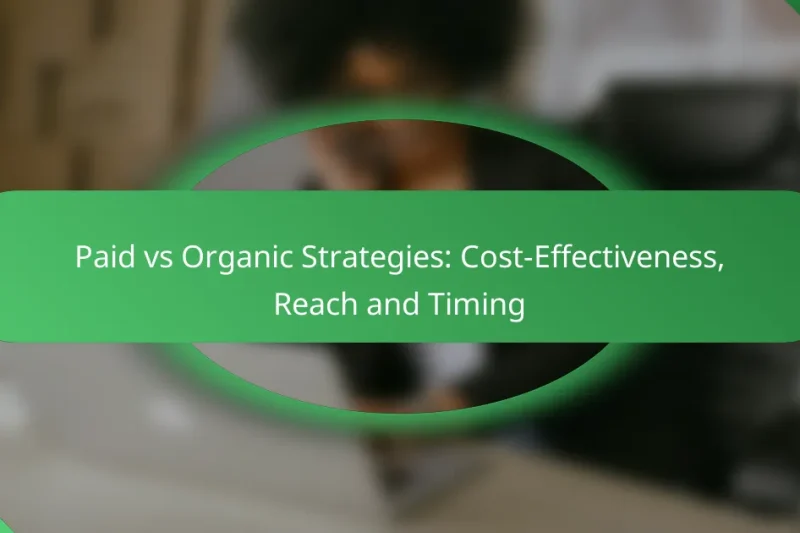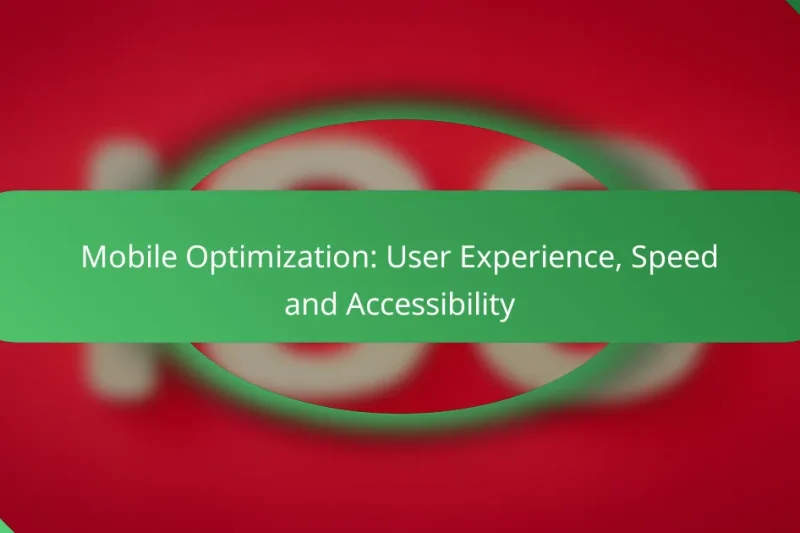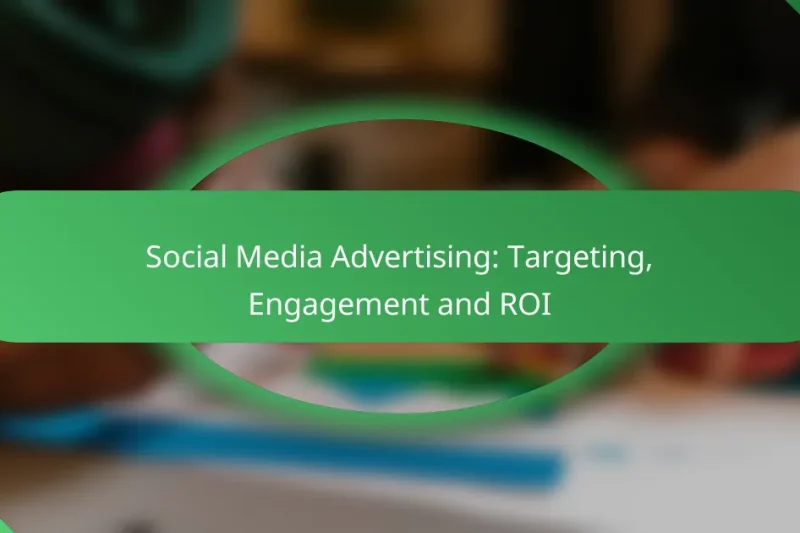In the competitive landscape of digital marketing, businesses must weigh the cost-effectiveness, reach, and timing of … Paid vs Organic Strategies: Cost-Effectiveness, Reach and TimingRead more
Digital Marketing for Political Campaigns
Digital marketing plays a crucial role in modern political campaigns by enabling targeted outreach and fostering voter engagement through data-driven strategies. By leveraging platforms like Facebook, Twitter, and Instagram, candidates can connect with specific demographics and enhance their campaign visibility. A well-crafted digital marketing strategy is essential for understanding the audience and effectively communicating campaign messages.
Mobile Optimization: User Experience, Speed and Accessibility
Mobile optimization is essential for enhancing user experience, speed, and accessibility on smartphones and tablets. By … Mobile Optimization: User Experience, Speed and AccessibilityRead more
Influencer Partnerships: Reach, Credibility and Engagement
Influencer partnerships have become a powerful tool for brands seeking to enhance their reach and credibility … Influencer Partnerships: Reach, Credibility and EngagementRead more
Social Media Advertising: Targeting, Engagement and ROI
Social media advertising has transformed the way brands connect with their audiences, emphasizing the importance of … Social Media Advertising: Targeting, Engagement and ROIRead more
Email Marketing Strategies: Personalization, Segmentation and Automation
Email marketing strategies that focus on personalization, segmentation, and automation are essential for maximizing engagement and … Email Marketing Strategies: Personalization, Segmentation and AutomationRead more
Digital Campaign Platforms: Features, Costs and User Experience
Digital campaign platforms play a vital role in modern marketing, offering diverse features and pricing options … Digital Campaign Platforms: Features, Costs and User ExperienceRead more
SEO Techniques: Keyword Research, On-Page Optimization and Link Building
Mastering SEO techniques is essential for improving your website’s visibility and attracting targeted traffic. Key components … SEO Techniques: Keyword Research, On-Page Optimization and Link BuildingRead more
How can digital marketing enhance political campaigns in the US?
Digital marketing can significantly enhance political campaigns in the US by enabling targeted outreach, fostering voter engagement, and optimizing campaign strategies through data-driven insights. Utilizing various online platforms allows candidates to connect with specific demographics, increasing the likelihood of voter support.
Targeted social media advertising
Targeted social media advertising allows political campaigns to reach specific voter segments based on demographics, interests, and behaviors. Platforms like Facebook, Instagram, and Twitter offer sophisticated targeting options that can help candidates tailor their messages to resonate with different groups.
For effective social media ads, campaigns should focus on clear messaging and compelling visuals. A/B testing different ad formats can help identify which messages perform best, ensuring that resources are allocated efficiently.
Email marketing strategies
Email marketing remains a powerful tool for political campaigns, providing a direct line of communication with supporters. Campaigns can use email to share updates, solicit donations, and mobilize volunteers, making it essential to build a robust email list.
To maximize engagement, emails should be personalized and segmented based on voter interests and past interactions. Regularly analyzing open and click-through rates can help refine strategies and improve future campaigns.
Content marketing for voter engagement
Content marketing involves creating valuable and informative content that engages voters and builds trust. This can include blog posts, videos, podcasts, and infographics that highlight key issues and the candidate’s positions.
Effective content should address voter concerns and encourage sharing on social media. Campaigns should consider using storytelling techniques to make the content relatable and memorable, fostering a deeper connection with potential voters.
Data analytics for campaign optimization
Data analytics plays a crucial role in optimizing political campaigns by providing insights into voter behavior and campaign performance. By analyzing data from social media, email campaigns, and website traffic, campaigns can make informed decisions to enhance their strategies.
Key metrics to monitor include engagement rates, conversion rates, and demographic insights. Regularly reviewing this data allows campaigns to pivot quickly and allocate resources to the most effective tactics, ultimately improving their chances of success.
What are the best platforms for political digital marketing?
The best platforms for political digital marketing include Facebook, Twitter, and Instagram, each serving distinct purposes. These platforms facilitate community engagement, real-time communication, and visual storytelling, making them essential for effective campaign strategies.
Facebook for community outreach
Facebook is a powerful tool for community outreach, allowing campaigns to connect with voters on a personal level. By creating targeted ads and engaging posts, candidates can foster discussions and build relationships with constituents.
Utilizing Facebook Groups can enhance community interaction, providing a space for supporters to share ideas and organize events. Campaigns should regularly post updates and respond to comments to maintain engagement and demonstrate responsiveness.
Twitter for real-time updates
Twitter excels in delivering real-time updates, making it ideal for sharing breaking news and important announcements. Candidates can quickly communicate their positions on current events, engage with followers, and respond to inquiries.
To maximize impact, campaigns should use relevant hashtags and participate in trending conversations. Regularly tweeting and retweeting can help maintain visibility and keep the audience informed about campaign developments.
Instagram for visual storytelling
Instagram is perfect for visual storytelling, allowing campaigns to share compelling images and videos that resonate with voters. High-quality visuals can capture attention and convey messages more effectively than text alone.
Using Instagram Stories and Reels can create a sense of immediacy and intimacy, showcasing behind-the-scenes moments and personal anecdotes. Campaigns should focus on authentic content that reflects their values and connects emotionally with their audience.
How to create a digital marketing strategy for a political campaign?
Creating a digital marketing strategy for a political campaign involves understanding the audience, setting clear objectives, selecting the right platforms, and planning content effectively. A well-structured approach can significantly enhance voter engagement and campaign visibility.
Define target audience
Identifying the target audience is crucial for tailoring messages that resonate. Consider demographics such as age, gender, location, and political affiliation to create a profile of potential voters. Use surveys and social media insights to gather data on their interests and concerns.
Segment your audience into groups based on shared characteristics. For instance, younger voters may prefer platforms like Instagram, while older demographics might engage more on Facebook. This segmentation allows for more personalized and effective messaging.
Set campaign goals
Establishing clear campaign goals is essential for measuring success. Goals might include increasing voter registration, boosting social media engagement, or driving attendance at events. Ensure these goals are specific, measurable, achievable, relevant, and time-bound (SMART).
Consider setting both short-term and long-term objectives. Short-term goals could focus on immediate outreach efforts, while long-term goals might aim for overall voter turnout. Regularly review and adjust these goals based on campaign progress and feedback.
Choose appropriate channels
Selecting the right digital channels is vital for reaching your target audience effectively. Common platforms include social media (Facebook, Twitter, Instagram), email marketing, and campaign websites. Each channel has its strengths and can cater to different audience segments.
Evaluate where your audience spends their time online. For example, if targeting younger voters, prioritize platforms like TikTok or Snapchat. Additionally, consider using paid advertising on these channels to enhance visibility and engagement.
Develop a content calendar
A content calendar helps organize and schedule campaign messaging across various platforms. Plan content types such as posts, videos, and blogs, and align them with key campaign milestones and events. This ensures consistent communication and maximizes audience engagement.
Include important dates such as debates, election days, and community events in your calendar. Regularly update the calendar based on audience feedback and engagement metrics to keep content relevant and effective.
What are the key metrics to measure in political digital marketing?
Key metrics in political digital marketing include engagement rates, conversion rates, and reach and impressions. These metrics help campaigns assess their effectiveness in reaching and influencing voters.
Engagement rates
Engagement rates reflect how actively users interact with campaign content, such as likes, shares, comments, and clicks. A higher engagement rate indicates that the content resonates with the audience, which is crucial for building support.
To measure engagement, divide the total interactions by the total reach or impressions, then multiply by 100 to get a percentage. Aim for engagement rates above 1-3% for social media posts, as this range is generally considered effective.
Conversion rates
Conversion rates indicate the percentage of users who take a desired action after interacting with campaign content, such as signing up for newsletters or donating. This metric is vital for understanding how well the campaign turns interest into action.
To calculate conversion rates, divide the number of conversions by the total number of visitors, then multiply by 100. A good conversion rate for political campaigns typically falls between 2-5%, depending on the platform and the specific call to action.
Reach and impressions
Reach measures the total number of unique users who see campaign content, while impressions count how many times the content is displayed, regardless of whether it was clicked. Both metrics help gauge the overall visibility of the campaign.
For effective political marketing, aim to maximize reach while maintaining a healthy ratio of impressions to engagement. A high number of impressions with low engagement may indicate that the content is not resonating with the audience.
What are the legal considerations for digital marketing in political campaigns?
Legal considerations for digital marketing in political campaigns include compliance with election laws, data privacy regulations, and advertising standards. Campaigns must ensure transparency in funding sources and adhere to rules regarding political advertising disclosures.
Compliance with election laws
Political campaigns must follow specific election laws that govern advertising practices. This includes ensuring that all digital ads are properly labeled as political and that they disclose who paid for them. Failure to comply can result in fines or other penalties.
Campaigns should familiarize themselves with both federal and state regulations, as these can vary significantly. For example, in the United States, the Federal Election Commission (FEC) sets rules that campaigns must follow, while individual states may have additional requirements.
Data privacy regulations
Data privacy is a critical consideration for political campaigns utilizing digital marketing. Campaigns must comply with regulations such as the General Data Protection Regulation (GDPR) in the EU or the California Consumer Privacy Act (CCPA) in the U.S. These laws dictate how campaigns can collect, store, and use personal data.
To avoid legal issues, campaigns should implement clear privacy policies and obtain consent from users before collecting their data. Regular audits of data practices can help ensure compliance and build trust with constituents.
Advertising standards
In addition to election laws and data privacy, political campaigns must adhere to advertising standards set by platforms like Facebook, Google, and Twitter. These platforms have specific rules regarding the content and targeting of political ads.
Campaigns should review the advertising guidelines of each platform before launching their campaigns. Non-compliance can lead to ads being removed or accounts being suspended, hindering campaign efforts.






